A Curator's Tour Through Fly Collections
By Erica McAlister
At the Natural History Museum, London, the diversity of Diptera specimens is vast and impressive. How are they researched and maintained?
At the Natural History Museum, London, the diversity of Diptera specimens is vast and impressive. How are they researched and maintained?

In my work as a senior curator specializing in flies at the Natural History Museum (NHM), London, I’m surrounded by approximately 2.5 million dead flies, some of them 350 years old, gathered from across the world and each fascinating in its own way.
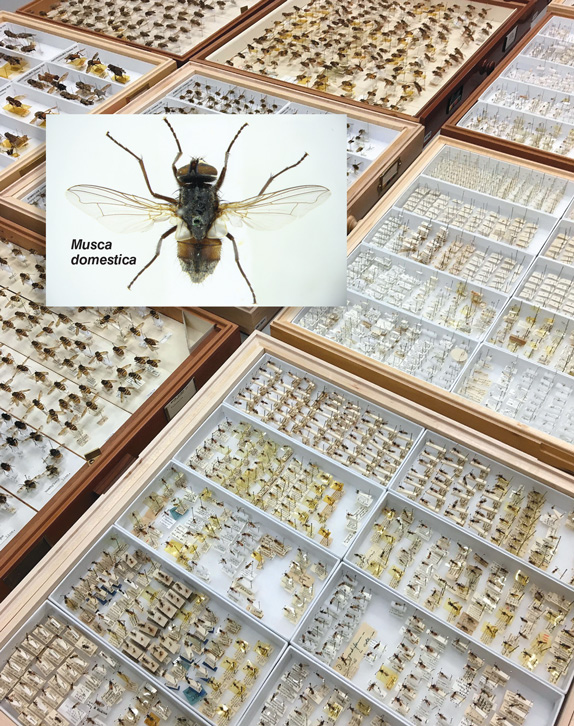
Drawers of fly specimens on pins sit in the Natural History Museum (NHM), London. The inset shows a pinned specimen of the common housefly, Musca domestica.
Image courtesy of Erica McAlister
Flies on pins, flies on slides, flies in bottles of alcohol, flies in milk bottles, flies made into cakes—the collection is vast and precious. The museum’s impressive stash of flies, arguably one of the largest globally, makes it possible for biologists to describe the richness of life on Earth—what species we have already named, what we have found that is new, what we are losing, and how we can help preserve what we still have.
Flies are one of the most species-rich and abundant groups of animals on the planet, with more than 165,000 species described to date. Even that number is probably a ridiculous undercount, as researchers are still working their way through megadiverse families and are only beginning to tally the myriad small, largely ignored species. There are more species of fly within the United Kingdom than there are mammal species on the whole planet. A single family of flies—the craneflies (Tipulidae)—includes more described species than all mammals and birds combined. Flies are not only ubiquitous and diverse, they also play crucial and underappreciated roles in their ecosystems, including decomposition, pollination, and as food sources for other animals. And, luckily for me, they seem to be absolutely everywhere.
I am not just a curator of dead flies in the museum’s collection. I also go out into the world of the living to collect flies and help fill in the gaps in our knowledge about them. Recently, I have spent my summer months collecting flies on the island of Dominica in the Caribbean, seeking out new species. This island’s rich biodiversity is well known, and researchers have been describing its vertebrate fauna for many years. By comparison, the island’s invertebrates, including its flies, have been poorly studied. We know a little about a few families, such as robber flies and hover flies, but there are few, if any, records of some of the more economically important groups such as the Muscidae, the houseflies. Love them or loathe them, many of these large flies are closely associated with humans (the clue is in the common name), and they prosper on our crops, waste, and livestock. They are not simply nuisances; some, we are discovering, play an important role in pollination.
Researchers have identified nearly 300 species of housefly in the United Kingdom, but to date only five have been described from Dominica, and four of these are not native to the tropics. These four are what we call synanthropic species, those that have been described from a specific region but have now spread around the world because of their affinity for people. We humans are very messy creatures, and houseflies benefit from it. In this case, these species were originally from Europe but have happily traveled across the seas on the many ships that went west. The rest of the housefly species are poorly studied, not only on this island but also across the West Indies.
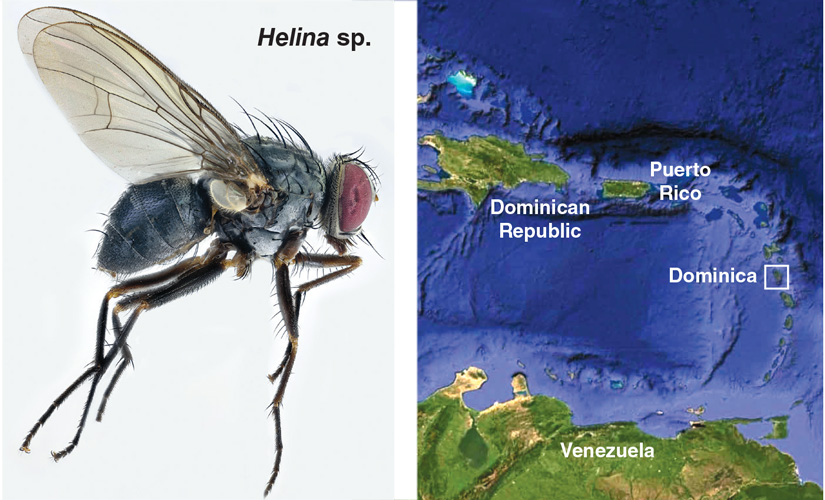
Map: Google Data SIO, NOAA, U. S. Navy, NGA, GEBCO Data LDEO-Columbia, NSF, NOAA
Flies and other insects are not the only organisms being studied there. I am working with a group of scientists who specialize in a range of taxa, including anoles, parrots, and Christmas tree worms, all funded by Operation Wallacea. This U.K. charity runs biodiversity field expeditions that offer students (secondary school and up) the opportunity to learn from publishing scientists and contribute to our scientific endeavors.
Nigel Wyatt (a colleague of mine at the NHM) and I are describing our findings from collections from Dominica. From the many thousands of insects that I have collected, we have now established that there are 15 genera in the family Muscidae recorded from the island, some of which are also new records for the West Indies. Within these genera are many new species to science. (See images above and below.) There is nothing more rewarding than telling a 15-year-old that the specimen they helped collect may be new to science, and watching a broad grin spread across their face, as they come to appreciate their contribution to this global taxonomic endeavor. And knowing that I too am helping us understand this planet that we share is deeply fulfilling.
To describe a new species, we make a detailed account of its distinctive features. Adult flies differ from other insects by having a combination of three morphological features: suctorial mouthparts, one pair of wings (hence the family name Diptera: di means “two,” and ptera means “wing”), and the presence of a pair of halteres, their balancing organs. However, there are many exceptions. This group of animals appears to have played around with their morphological blueprint more than most, and there are many species with no mouthparts, no wings, or no halteres—a complete headache for early-career taxonomists—but thankfully the houseflies seem to have kept themselves more or less in line with the standard-issue fly shape.
By contrast, another group of flies that I am working on from Dominica has a rather unusual morphology. Bat flies within the families Streblidae and Nycteribiidae are bloodsuckers (ectoparasites) with flattened, spiderlike bodies that lack eyes or wings (see below). They stay attached to their bat hosts for most of their lives. Most people would not be enthusiastic about spending time with such animals, but I am fascinated by creatures that have evolved such weird and wonderful life history traits. Adult female bat flies give birth to live young, which develop in the uterus and are fed by an internal lactating gland, a trait that makes these mothers some of the most nurturing of all flies—a relatively uncommon trait in predominantly egg-laying insects. In our work, we pick off these flies from the bats to determine which species of fly lives on which species of bat, and so we are building ecological pictures of how dependent some species are on others. With a pair of forceps and a bat held splayed apart, we pick the drunken-spider-looking flies off the bats, who seem less than impressed by our antics. These flies are then preserved in ethanol for later identification in my lab.
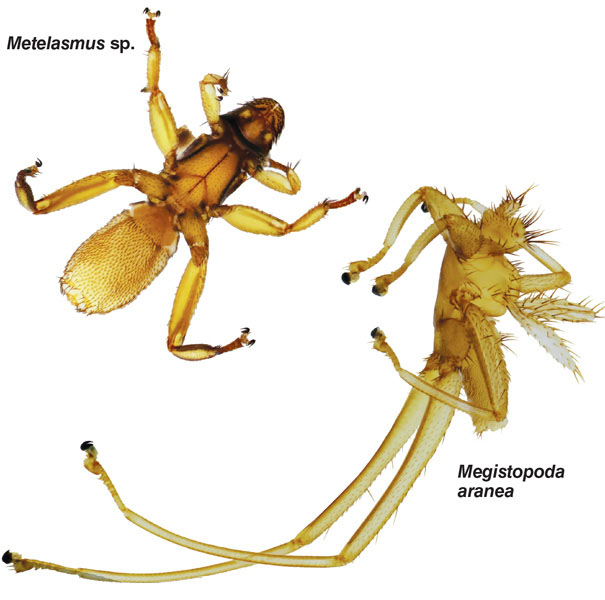
Image courtesy of Erica McAlister.
After our specimens have been properly labeled and our findings published, some of the material we have collected will be returned to Dominica for inclusion in their local collections. The rest will remain in London, joining the millions of other flies that are held as part of the NHM’s ever-growing repository of species.
My flies join a collection that began more than 350 years ago. Sir Hans Sloane, a doctor and collector of artifacts, both natural and human, amassed an enormous collection from all over the world. Upon his death in 1753, the collection was bequeathed to the British government with the understanding that it be used for the establishment of a museum, and so the British Museum was born. The NHM is a child of the British Museum, and eventually opened its doors to the public in 1881.
Taxonomy, the description of specimens, is more important than ever. To help conserve this planet, we must know what is here.
My properly documented Dominican material, labeled with where, when, and by whom they were collected for any future taxonomic or ecological analysis, now joins one of the most important historic and geographically distributed collections in the world. Not all the specimens in the collection have the best labeling. For example, there is a moth that just has the word “foreign” written on its label, and a horsefly simply labeled “female.” But some of the oldest material does have good labels.
We have a specimen from the gardens at Hampton Court that was collected around 1680 by Queen Mary’s gardener, Leonard Plukenet. Plukenet was a highly regarded botanist, publishing species accounts of both native and exotic plants and keeping those botanical specimens pressed in books. He also kept the insects that were associated with them—flattened as well among the pages of a very large book (see below, inset). These historic specimens are very fragile, but their color has preserved well, and they are a great example of early specimens with known sites of collection.
Alongside its historic importance, the collection’s wealth of type material makes it a unique and invaluable resource. When describing a new species, we generally pick one individual as the name-bearing “type” specimen. As such, that individual becomes one of the most important specimens for that species, because it is the one that future taxonomists and other researchers will refer to. Carl Linnaeus, the Swedish botanist and zoologist, is credited for formalizing in 1758 the binomial naming system that refers to all organisms by a genus and species, organized into broader related groups, that is still used by scientists across the globe. His collection is held by the Linnean Society, but the NHM holds many millions of other type specimens that are needed by researchers to compare with specimens that they believe are new to science.
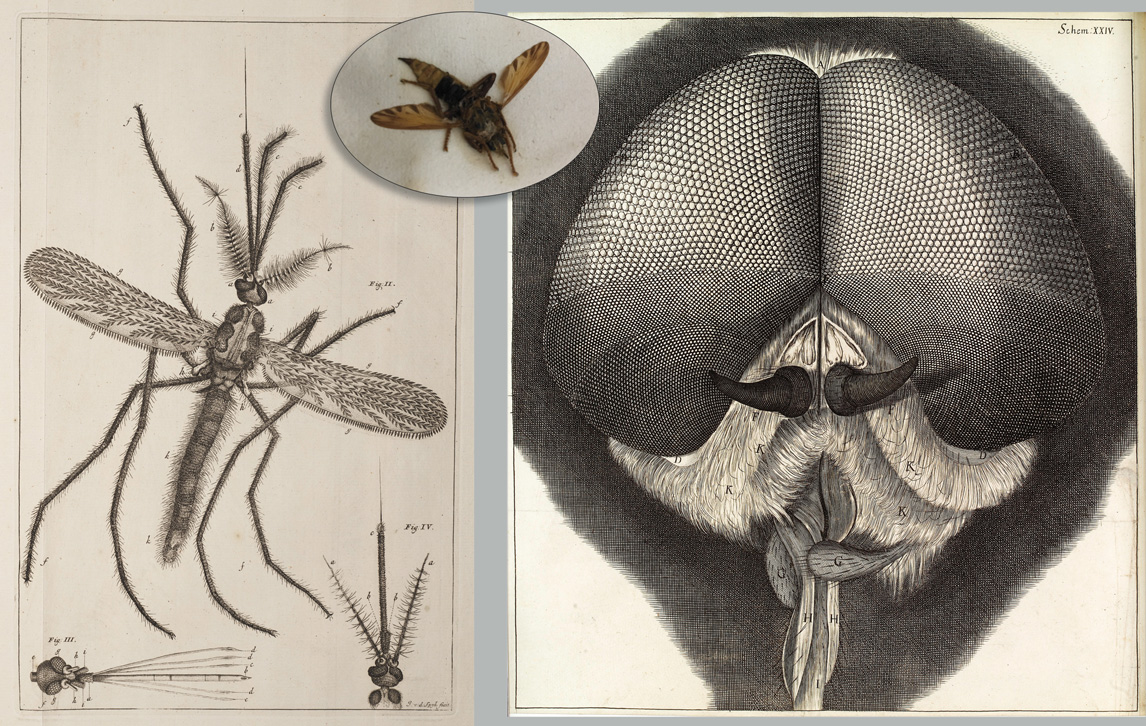
Wellcome Images/Wikimedia Commons
The emergence of the microscope in the 1600s also advanced the early study of flies. Robert Hooke, armed with the newly invented microscope, set about drawing flies and many of their amazing anatomical features. The detail with which he drew the horsefly eye in the mid-1600s is incredible (see above, right): One can see in the drawing the differences in the sizes of the individual lens of the fly’s eye, the details of which entomologists are only beginning to truly understand today through examining and imaging our specimens.
Jan Swammerdam, a Dutch aficionado of the microscope, was also an inspirational figure from the 17th century. I have seen original copies of his diagrams of the flies that he studied and can attest to their accuracy as well as their beauty. Like Hooke, Swammerdam was taken by the eyes, but those of the larval stage of mosquitoes. Like many insects, flies, including mosquitoes, go through a complete morphological change from their larval stage to adulthood, because the features of the adults are not necessary for the previous stages and so only develop for the final reproduction and dispersal. Swammerdam proved that some of these marvelous creatures change from basic feeding machines as larva to some of the planet’s best explorers, as adults developing legs, wings, and more complex eyes. He drew the separated components of the mosquito’s mouthparts with accuracy but also corrected himself with later additions to images, such as adding the scales on their wings (see above, left). Microscopic examinations have been progressing and developing continually, with current-day researchers producing very detailed images.
I will never be the artist that Swammerdam was, but maybe the scientific images and photographs I make will help in some small way to further our knowledge. I can use modern equipment to reveal details of a fly’s biology far beyond what early researchers could study. I can study the external structures, as Hooke and Swammerdam did, such as an eye’s ommatidium—an individual eye facet—at incredibly high resolution using a scanning electron microscope or just my everyday desktop microscope.
One of the more common methods for imaging specimens is to create a composite image, made from a series of stacked images, that shows the key morphological features—the eyes, the vein pattern on the wings, the genitalia, and so on—in great detail in one image. The custom-built imaging setup that we use in the Diptera section is, thankfully for me, very easy to operate. During this imaging process, my flies sit on a specialized platform, illuminated by LED wedge lights, above which is secured a Canon 5DSR on the end of a movable StackShot rail, all of which is compact enough to sit on an office desk. The rail holding the camera is automatically raised or lowered so that multiple images can be taken at different depths of field.
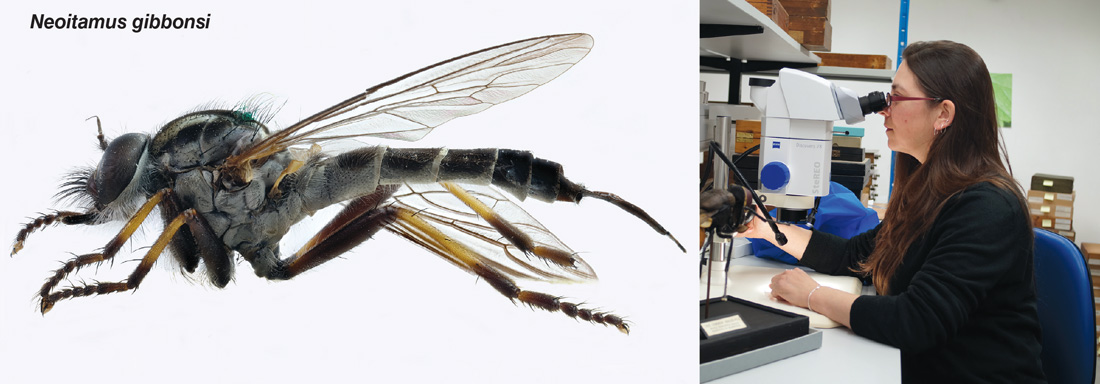
Images courtesy of Erica McAlister.
I may generate a hundred or so images for a particularly chunky specimen, such as a robber fly (see above). Robert Lavigne, an emeritus professor at the University of Wyoming, and I worked on several genera within this family, developing new identification keys and describing new species.
It is a time-consuming process. First, the labels are removed from the specimen’s pin, and then these (along with the specimen) are separately imaged. Next, the specimen is placed on a stage, which is then manipulated to the very bottom and top of the specimen and set up to take a series of images, depending on what part of the specimen is of interest. Each specimen takes a couple minutes to process, but that’s not the end. These images must then be cleaned and edited in Photoshop, a process that may take an hour or so per specimen. Ultimately, imaging specimens to this level of detail is worth it. Not only did Lavigne and I use them in our publications, but these images are also made available online through the museum’s data portal. Modern digital imaging makes it much easier to share specimens that, due to their rarity or fragility, we would be unwilling to send in the mail.
Taxonomy, the description of specimens, is more important than ever. To help conserve this planet, we must know what is here. And we are not even close to knowing that. Most of the larger, obvious species have been described. One or two new mammals may be described in a given year—and nowadays these tend to be from museum collections that have been reanalyzed. With insects we have a long way to go. Each year, NHM scientists and their associates describe around 500 species, the majority of which are invertebrates, but this progress falls far short of the predicted 9 million insects that are thought to remain unnamed. By helping researchers quickly access the images, we curators can speed up this taxonomic process.
All of Wyatt’s and my descriptions of new species from Dominica, along with their images, will be online and open access, and then the specimens will be housed in a sealed drawer, jar, or slide (depending on how they were preserved) and kept protected in a secure cabinet, along with millions of other insects in the Cocoon at the NHM. The Cocoon is an enormous collection space that contains approximately 20 million or so insects in an environment that is carefully controlled for temperature, humidity, and pests. Keeping specimens safe is a crucial part of maintaining museum collections. I maintain and update specimens’ storage (both electronic and physical) to ensure they will be around for hundreds of years. There is a fair amount of basic maintenance needed for preserving a collection of this size. The specimens in drawers and slides need to be checked for any damage (such as pests or verdigris), their housing upgraded, their names checked, and the relevant databases updated. And that is not including the collections preserved in spirits inside jars, which is in another building!
Scientists’ progress describing species falls far short of the predicted 9 million insects that are thought to remain unnamed.
Last year, I finished a 10-year re-curation project on the world’s bee flies—many of the species in this group mimic bees (and wasps) but do not sting (see, for example, the photo of Bombylius major in the images at the end of this article). All 350 drawers of these flies have now been upgraded, with the specimens in new unit trays made of conservation-grade paper and card. All names have been checked, and barcodes were added to many of the specimens. These barcodes help us track specimens in publications. Gradually, we are adding these barcodes to the rest of the specimens—a long but worthwhile process. We can now quickly scan specimens with a handheld scanner to pull up their data, using unique codes to track which specimens have been included in the scientific literature—a useful method of understanding the value of our collections to the wider scientific community.
It takes time and money to maintain our collections, and I am often asked why there is a need to have them at all. People often wonder whether images are now sufficient for identifying animals from both specimens in our collections and those in the field, and for writing taxonomic descriptions. Images are now exceptionally good, but there are many reasons why we need to preserve the actual specimens.
First, our methods for looking at specimens change. We may think our ways of looking at a specimen are great today, but I hazard to guess that Linnaeus also thought so when he described species. Linnaeus’s original species description in Latin for Musca domestica (see below)—one of the most common flies on the planet—reads simply: “Plumose antennae with black hairs, thorax with five false lines, abdomen elegantly tessellated.” That description is equally applicable to thousands of other species of flies. That was hundreds of years ago, but even photography from several decades ago has been superseded.

Image courtesy of Erica McAlister.
Second, modern descriptions may consider many different morphological features. From the tips of their antennae to the end of their abdomens, flies have evolved to suit many different environments, adapting to get the best from what many would consider a bad situation—after all, living in a compost heap or up the nostril of a camel is not considered a dream home by most people. We need the preserved specimens to be able to compare and contrast with other specimens, and there may be features not mentioned in the original descriptions that become important for differentiating one species from another.
Third, flies have adapted and speciated at an impressive rate, and their morphology does not necessarily reflect behavioral or molecular changes. Innovative developments in molecular technology are making it possible to answer some previously unattainable species resolutions, and, once more, the actual specimens are necessary for such analyses. Making sure that identifications are correct affects biodiversity studies, food security, and human health.
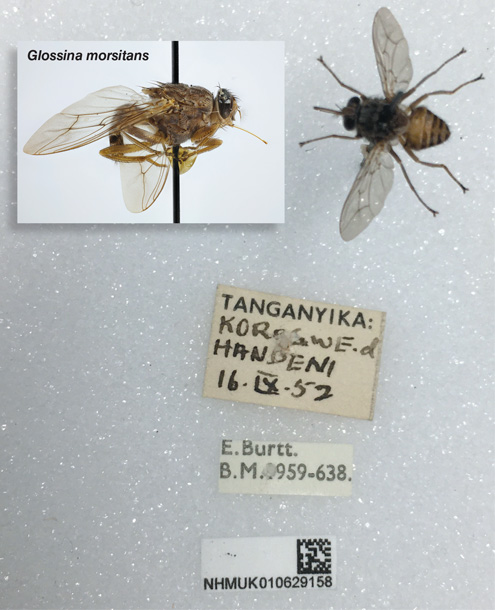
Image courtesy of Erica McAlister.
Most specimens from the past few hundred years were preserved for later morphological analyses. Many studies—for example, research into disease vectors such as mosquitoes—depend critically on reviewing physical specimens in the collection. Mosquitoes are vectors of some of the most important pathogens in human societies, both past and present, due to the blood feeding activities of the females. The mosquito herself is not doing the major harm, but rather the parasite, virus, or bacterium that she is unwittingly spreading. Millions of people across the globe are affected by malaria, dengue, Zika, and yellow fever, to name but a few of the life forms that these females may carry. But many of these mosquitoes are what we call cryptic species, a group of organisms that look alike but are in fact many distinct species. The biggest vectors of malaria in Africa are found within two such species groups, the Anopheles gambiae group and the Anopheles funestus group.
The Anopheles gambiae species group is found in sub-Saharan Africa and comprises at least eight species. As adults, these eight species are pretty much visually identical. Instead, these mosquitoes are distinguished by larval morphology, adult behavior, or preferred host. The same goes for the A. funestus species group, which includes at least seven species. One way we can tell them apart is through their genetics.
Our collected specimens—more than 300 drawers containing thousands of mosquitoes—help researchers answer all sorts of exciting questions, because we have documented mosquitoes from previous times. For example, in collaboration with the Wellcome Sanger Institute and biologists in the United States, we are sequencing another disease-vector mosquito, Culex pipiens, to find out about its notorious belowground form: the aptly named London Underground mosquito that made headlines during the Blitz in World War II for attacking the already beleaguered residents of London. The belowground form, Culex pipiens molestus, reportedly evolved in situ from the bird-biting aboveground population, but to date this hypothesis is far from proven. We have now imaged both below- and aboveground forms and sent them off for DNA sequencing, so that their origin and complex evolutionary history may be ascertained.
We are always learning new things from old fly specimens. When DNA sequencing was first used to help with species determinations, fresh material was needed to ensure that the DNA had not fragmented to the point of being unreadable by the original sequencing machines. Now, we can recover fragmented parts of DNA and amplify them using PCR so that we have long, readable chains. With most museum specimens, therefore, we were only previously able to obtain barcodes—a short section of DNA from a specific genomic region—to compare species. Now we can replicate the whole genome. We no longer have to rely on freshly collected specimens from the field but instead can use material that is more than a hundred years old that is sitting in our collections. These old specimens may be able to tell greater stories, such as what mosquito population structures looked like before insecticide use. Still, there are drawbacks to these methods.
Many molecular techniques are destructive to specimens, because they require the removal of a leg or something similar to provide enough DNA for analysis. I can’t just have anyone remove flies’ body parts willy-nilly. I have to protect these specimens for the future. So, I do not always agree to someone sequencing a specimen.
To get around this obstacle, new nondestructive methods are under development, with some success at extracting whole genomes from beetles, ants, and some flies. Results from previous studies found that ants and beetles both looked great afterward, but the flies were, at best, a disheveled mess. Flies are a lot less sclerotized—that is, their exoskeletons are more flexible than those of the former two groups. Bathing any insect in reagents to remove DNA weakens the exoskeleton, resulting in much damage to the morphological features of the flies.
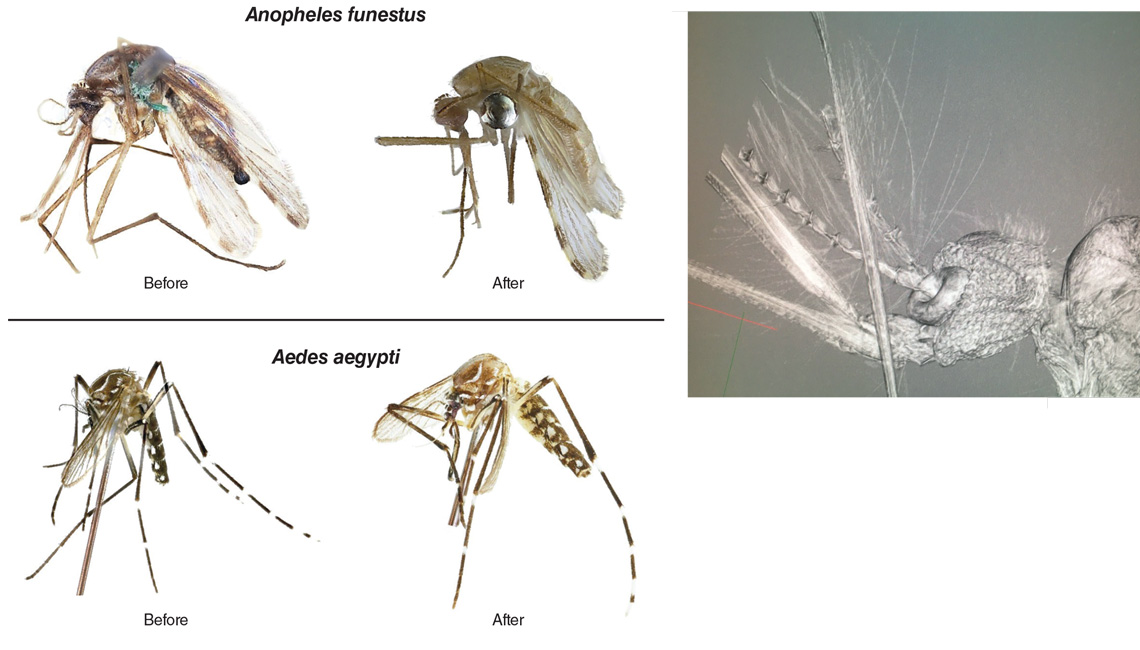
Image courtesy of Erica McAlister.
In collaboration with evolutionary geneticist Mara Lawniczak and postdoctoral researcher Petra Korlevic of the Wellcome Sanger Institute, we have been developing new protocols for extracting precious genetic material without damaging the flies. We have been working on mosquitoes, because not only are they rather important, but also they are some of the flimsiest of flies. After trial and error, we have identified proteinase buffers that cause minimal damage, a finding we published in Genome Biology and Evolution in 2021. Our new method offers a way to explore both the genomes and morphology of historic collections.
The mosquitoes selected from the collection were sent to the Sanger Wellcome Institute to be sequenced using a variety of DNA extraction buffers. Before and after the sequencing, I took high-resolution images of the mosquitoes’ heads, wings, and genitalia—all the parts that are useful for morphological taxonomy (see above).
I not only photographed these mosquitoes, I also became their glorified hairdresser. The specimens left the museum on pins but came back in ethanol, so before the “after” images could be taken I had to critical point-dry them. In this process, all the ethanol used to store the specimen is gradually replaced with liquid carbon dioxide, which is subsequently heated until it evaporates. The specimen remains intact, unlike the mangled specimens with collapsed eyes and shriveled wings that had air-dried. Once washed and blow-dried, these specimens were ready for their final photo to enable us to compare how the extraction processes affected their morphology.
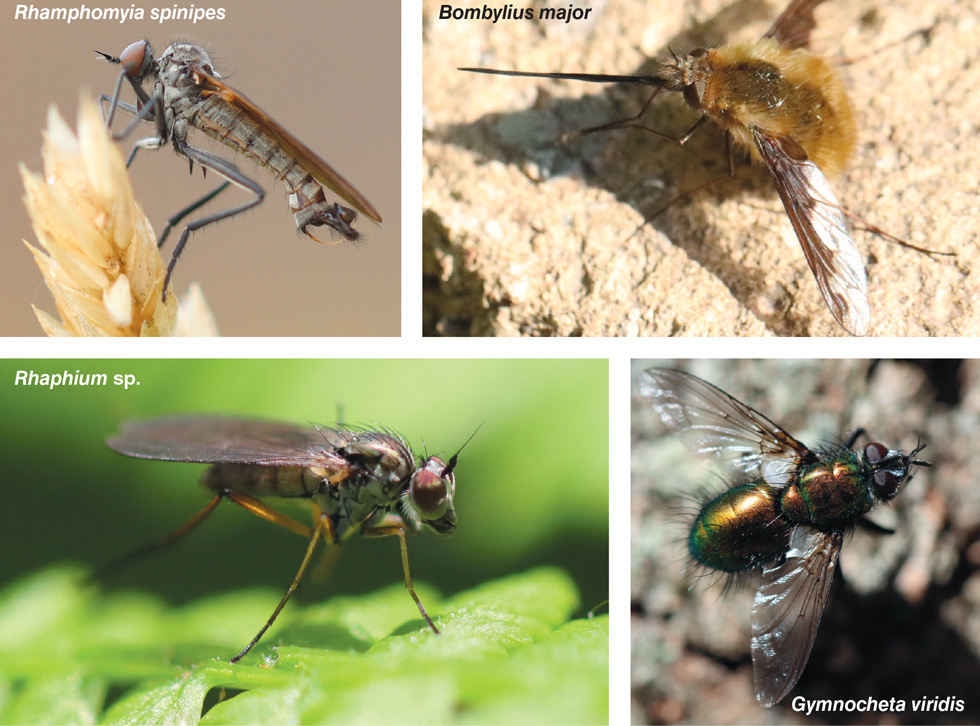
Images courtesy of Erica McAlister
Our knowledge of flies is expanding, but we still have so much to learn. We are adding to the collections all the time, as I, along with many other researchers, undertake fieldwork around the globe—and not just in sun-drenched Caribbean idylls. I have collected mosquitoes from a pigpen in a zoo in South London, I have vacuumed mosquitoes from a tethered bull in a farmer’s hut in Indonesia, and I have sampled flies off piles of penguin guano in South Africa, none of which were very salubrious locations.
We all need to do our part to conserve our planet. For me, that means traveling to some of the most beautiful and some of the most grotesque parts of the globe to get a picture of the living flies still out there. It also means watching over dead flies for future generations, no matter how nasty they may appear to others. More often than not, they turn out to be rather special.
Click "American Scientist" to access home page
American Scientist Comments and Discussion
To discuss our articles or comment on them, please share them and tag American Scientist on social media platforms. Here are links to our profiles on Twitter, Facebook, and LinkedIn.
If we re-share your post, we will moderate comments/discussion following our comments policy.